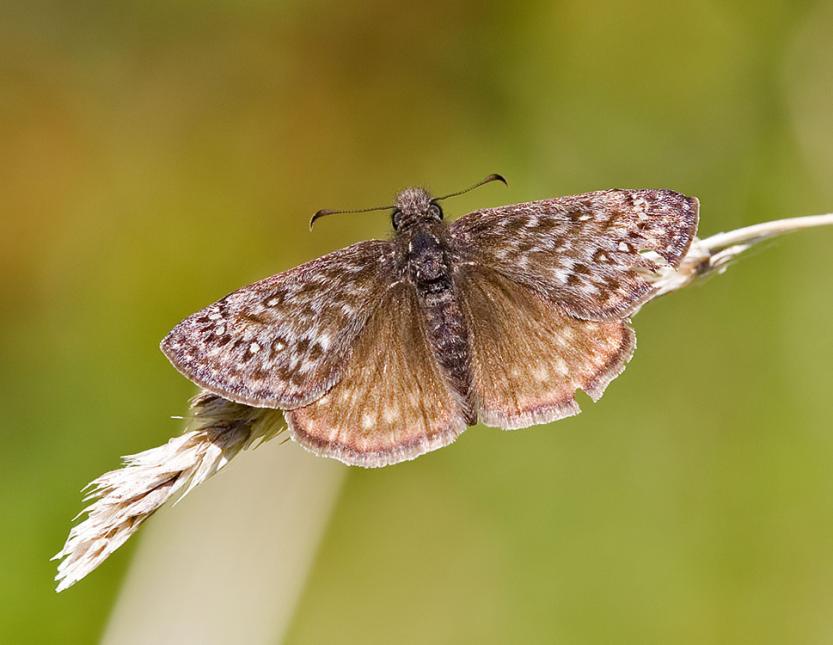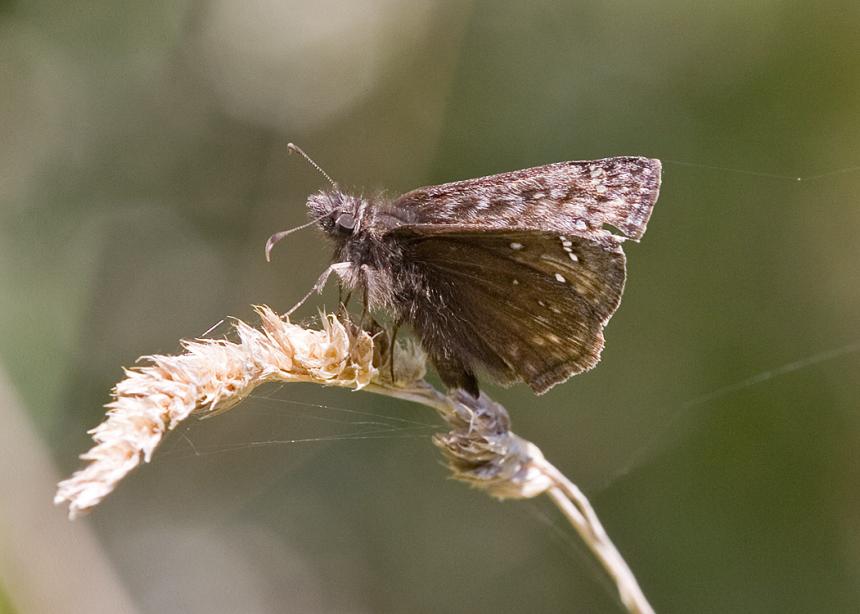Moderate-
High
The western Washington population size of the Propertius duskywing is low and is considered to have a declining trend. This butterfly is recognized as "Species of Greatest Conservation Need" throughout its range in western Washington due to the small number of isolated populations, specialized and restricted habitat, and known threats to its habitat. Research is needed to quantify specific habitat requirements including vegetation structure, food plant size and density, and key habitat features. In Washington, there are only 6 to 10 populations in four counties (Mason, San Juan, Skamania and Thurston).
Description and Range
Physical description
The Propertius duskywing is the largest of our duskywing species with a wingspan of up to one and three-quarters inches. The upperside of the wings are brownish with fore wings more mottled gray; the underside of the hind wings has well-defined spots. The sexes are dimorphic, the female wings are lighter and spots on both wings are larger. Sexual dimorphism means that males and females have different physical characteristics, such as color and size.
Ecology and life history
The Propertius duskywing is an obligate of Garry oak (Quercus garryana), meaning it is dependent on this oak for its survival. This oak serves as the butterfly’s hostplant where developing caterpillars (larvae) feed on oak leaves for nourishment. The primary nectar plant for this species is common camas (Camassia quamash).
The Propertius duskywing inhabits low-elevation (up to 2000 feet), open-canopied, oak woodlands and savannah. Oak woodlands are rare, patchily distributed, and declining in western Washington. Research is needed to determine the specific Garry oak understory requirements of the species’ larvae for overwintering, and by pupae for their development. Leaf litter is important to protect the larvae during hibernation. In the spring pupation occurs in a vague cocoon.
These skippers complete a single life cycle annually (univoltine). They are sedentary butterflies and do not migrate; instead, the species inhabits sites year-round (as egg, larva, pupa and adult), typically moving within only a few hundred meters of their natal locations.
Adults emerge from their chrysalids (pupae) during April through May. Males begin emergence first, followed by females; late-season individuals are primarily or solely females. Weather influences butterfly emergence and the flight period duration, with wet or cold conditions delaying emergence.
Both males and females feed by using their long proboscis to sip floral nectar.
Male skippers seek mates by perching on low vegetation and then darting out to inspect passing butterflies. Males that detect females commence courtship behavior; when males detect another male they engage in a territory defense behavior of tight, upward spiraling flight.
Females search for egg-laying sites by slowly flying and hovering just above hostplant vegetation and then depositing single eggs.
Skipper larvae conceal themselves in silken shelters and primarily feed at night. Propertius duskywings are members of the Pyrginae subfamily, whose larvae construct large cocoons in folded oak leaves, which drop to the ground over the winter, where pupation occurs in early spring. The Propertius duskywing overwinter as larvae.
Geographic range
Overall, the range of the Propertius duskywing is aligned with its oak host distribution in southwest British Columbia, Canada; the south and north Puget Sound and eastern slope of the Cascade mountains in Washington; western Oregon; and south to northwest California. In Washington, the butterfly occurs in a few small, isolated populations. Occurrence has been documented in Mason, San Juan, Skamania, and Thurston counties.
For a map of range-wide distribution and conservation status of the Propertius duskywing, check out NatureServe Explorer.
Climate vulnerability
Sensitivity to climate change
Moderate-
High
Propertius duskywing sensitivity is likely driven by temperature. This species exhibits some physiological sensitivity to warming temperatures, as well as indirect sensitivity to temperature via habitat changes. Temperature influences butterfly behavior (e.g., mating, foraging, egg-laying time), adult life span, and larval development. Cool, wet spring conditions limit adult activity and therefore fecundity. Warming temperature may also affect phenological timing between PD and key plant species (host and nectar plants) and possibly causing low availability of nectar resources and pre-mature desiccation of larval forage, leading to reduced fitness or starvation of adults or larvae. A study of Canadian populations found that adult flight phenology varied according to daily temperature, although larval development did not vary with temperature directly. A separate study found that warmer winter temperatures [+39°F (+4°C) higher than average] enhanced energetic drain on overwintering duskywing larvae and caused sublethal effects, and that increasing winter temperatures are likely to enhance desiccation stress for this species. Warming temperatures, including later first frost could also affect PD by altering the timing of their oak hosts leaf drop (abscission); larvae feed and develop on leaves, then spin a silky cocoon-like enclosure within a leaf, which falls to the ground where pupation takes place - changes in the timing of the transition from tree canopy to ground cover environments could impact this stage of development. Severe drought could reduce fitness of oak trees and palatability of oak leaves.
Exposure to climate change
Moderate-
High
- Increased temperatures
- Later first frost
- Drought
Conservation
Conservation Threats and Actions Needed
- Invasive and other problematic species
- Threat: Oak woodland and savanna being invaded by non-native shrubs and grasses, invasive plants
- Action Needed: Using herbicide, fire, and mechanical methods to restore native prairie; planting/seeding native oak woodland and savanna
- Threat: Oak woodland and savanna being invaded by native trees, especially Douglas-fir
- Action Needed: Remove invading trees
- Resource information collection needs
- Threat: Knowledge of current distribution of this butterfly is incomplete
- Action Needed: Revisit historic locales and search for new populations
- Fish and wildlife habitat loss or degradation
- Threat: Oak woodland requisite habitat is still unprotected from development
- Action Needed: Review proposed projects and protect oak woodland and savanna habitat
See the Climate vulnerability section above for more information about the threat posed by climate change to this species.
Resources
References
Beyer, L. and C. Schultz. 2010. Oviposition selection by a rare grass skipper Polites mardon in montane habitats: Advancing ecological understanding to develop conservation strategies. Biological Conservation 143:862-872.
Crawford, R. and H. Hall. 1997. Changes in the south Puget Sound prairie landscape. Pp 11-15 in P. Dunn and K. Ewing (eds.) Ecology and Conservation of the south Puget Sound Prairie Landscape. The Nature Conservancy, Seattle, Washington . 289 pp.
Guppy, C.S., Shepard, J and Royal British Museum. 2001.Butterflies of British Columbia : including western Alberta, southern Yukon, the Alaska Panhandle, Washington, northern Oregon, northern Idaho, northwestern Montana: UBC Press: Vancouver, 414 pp.
Hays, D., A. Potter, C. Thompson, and P. Dunn. 2000. Critical habitat components for four rare south Puget Sound butterflies. Final report to The Nature Conservancy. Washington Department of Fish and Wildlife. Olympia.
Henry, E. and C. Shultz. 2012. A first step towards successful conservation: understanding local oviposition site selection of an imperiled butterfly, mardon skipper. J. Insect Conserv. DOI 10.1007/s10841-012-9496-x.
James, D. and D. Nunnallee. 2011. Life Histories of Cascadia Butterflies. Oregon State University Press, Corvallis. 447pp.
Pyle, R. 2002. The Butterflies of Cascadia. Seattle Audubon Society. Seattle, WA. 420 pp.
Pyle, R. 1989. Washington butterfly conservation status report and plan. Washington Department of Fish and Wildlife, Olympia. 216pp.
Pyle, R.M. and LaBar, C.C. 2018. Butterflies of the Pacific Northwest. Timber Press. 461 pp.
Schultz, C., E. Henry, A. Carleton, T. Hicks, R. Thomas, A. Potter, M. Collins, M. Linders, C. Fimbel, S. Black, H. Anderson, G. Diehl, S. Hamman, R. Gilbert, J. Foster, D. Hays, D. Wilderman, R. Davenport, E. Steel, N. Page, P. Lilley, J. Heron, N. Kroeker, C. Webb, and B. Reader. 2011. Conservation of prairie-oak butterflies in Oregon, Washington, and British Columbia. Northwest Science 85: 361–388
Takaoka, S., and F. Swanson. 2008. Change in extent of meadows and shrub fields in the central western Cascade Range, Oregon. The Professional Geographer 60:527-540.
Thompson, J. 2007. Mountain meadows—here today, gone tomorrow? Meadow science and restoration. Science Findings Issue 94. PNW Research Station, Portland, OR. https://www.fs.usda.gov/research/treesearch/27444
Other resources
- A Region Specific Guide to Butterflies of South Puget Sound, Washington (R. Gilbert & A. Potter 2014)
- Butterflies and Moths of North America - Propertius Duskywing
- Xerces Society - Butterfly Conservation

